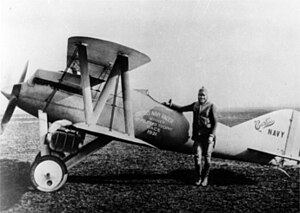avia.wikisort.org - Aeroplane
The Curtiss CR was a racing aircraft designed for the United States Navy in 1921 by Curtiss. It was a conventional single-seater biplane with a monocoque fuselage and staggered single-bay wings of equal span braced with N-struts. Two essentially similar landplane versions were built as the CR-1 and CR-2, which were both eventually converted to seaplanes as the CR-3 in 1923 and CR-4 in 1924. A refined version was developed for the US Army Air Service under the designation R-6. These latter two aircraft featured refined aerodynamics included surface-mounted radiators.
| Model 23, CR, R-6 | |
|---|---|
 | |
| The CR-1 with Bert Acosta, 1921 | |
| Role | Racing aircraft |
| Manufacturer | Curtiss Aeroplane and Motor Company |
| First flight | 1 August 1921 |
| Primary user | United States Navy |
| Number built | 4 |
Operational history

The Curtiss CRs enjoyed successful racing careers. Their first major win was at the 1921 Pulitzer Trophy race, where piloted by Bert Acosta the CR-1 took first place with an average speed of 176.75 mph (283.49 km/h), nearly two minutes ahead of its closest rival. The following year, this aircraft was modified and redesignated CR-2 and joined in the Pulitzer race by a second aircraft built to the same new standard, plus two R-6s flown by Army pilots. These Curtiss aircraft took first through fourth place, the two R-6s followed by the two CR-2s. The race was won by Lt. Russell Maughan with an average speed of 205.856 mph (330.172 km/h) with Lt. Lester Maitland in second place (198.850 mph/318.936 km/h). Maughan's effort incidentally broke every closed-circuit airspeed record up to 124 mi (200 km). The CR-2s took third and fourth places piloted by Lt Harold Brow (average speed 193.695 mph/310.667 km/h) and Lt Jg Al Williams (average speed 187.996 mph/301.527 km/h).
The Army built upon this success with the R-6s by using the aircraft to break the world airspeed record before 1922 was over, Gen Billy Mitchell flying one to 224.28 mph (359.72 km/h) on 18 October. In March the following year, an R-6 flown by Lt. Maughan lifted the record to 236.587 mph (380.74 km/h). The R-6 design was developed in 1923 into the longer-winged XPW-8, the prototype of the PW-8 fighter.
In 1923, the CR-2s were fitted with floats for the Schneider Trophy race and redesignated CR-3. The aircraft took first and second place, piloted by David Rittenhouse (average speed 177.977 mph (154.658 kn; 286.426 km/h) and Rutledge Irvine 173.932 mph (151.143 kn; 279.916 km/h). After the 1924 Schneider Trophy race was cancelled, CR-3 A6081 was flown by Lt. G.T. Cuuddihy to set up new World's closed-course seaplane record oc 188.07 mph (163.43 kn; 302.67 km/h).
A6081 was further modified as the CR-4 for use as a test-bed and trainer for the 1926 Schneider Trophy racing team.
Variants
- CR-1
- the first CR with US Navy serial A6080, with Lamblin radiators between the undercarriage struts.
- CR-2
- the second CR A6081, fitted with streamlined wheels and wing surface radiators.
- CR-3
- both A6080 and A6081 were converted to CR-3 standard with floats and 475 hp (354 kW) Curtis D-12 5PL engines.
- CR-4
- CR-3 A6081, modified as a test-bed and trainer for the 1926 Schneider Trophy race team.
Operators
 United States
United States
- United States Navy (CR)
- United States Army (R6)
Specifications (CR-3 Seaplane)

Data from Curtiss Aircraft 1907–1947[1]
General characteristics
- Crew: 1
- Length: 25 ft 0.375 in (7.62953 m)
- Wingspan: 22 ft 8 in (6.91 m)
- Height: 10 ft 9 in (3.28 m)
- Wing area: 168 sq ft (15.6 m2)
- Airfoil: Sloane[2]
- Empty weight: 2,119 lb (961 kg)
- Gross weight: 2,746 lb (1,246 kg)
- Powerplant: 1 × Curtiss D-12 5PL V-12 water-cooled piston engine, 475 hp (354 kW) at 2,300 rpm
- Propellers: 2-bladed Curtiss-Reed
Performance
- Maximum speed: 194 mph (312 km/h, 169 kn)
- Range: 281 mi (452 km, 244 nmi) at full throttle
- Service ceiling: 22,000 ft (6,700 m)
See also
Related development
Aircraft of comparable role, configuration, and era
References
- Bowers, Peter M. (1979). Curtiss aircraft, 1907–1947. London: Putnam. pp. 228–232. ISBN 0370100298.
- Lednicer, David. "The Incomplete Guide to Airfoil Usage". m-selig.ae.illinois.edu. Retrieved 16 April 2019.
- Bibliography
- Taylor, Michael J. H. (1989). Jane's Encyclopedia of Aviation. London: Studio Editions. p. 796.
- World Aircraft Information Files. London: Bright Star Publishing. pp. File 891, Sheet 45.
External links
| Wikimedia Commons has media related to Curtiss CR. |
На других языках
[de] Curtiss R-6
Die Curtiss R-6 war ein Rennflugzeug, mit dem im Jahre 1922 das Pulitzer Trophy Air Race gewonnen wurde.- [en] Curtiss CR
[fr] Curtiss CR
Le Curtiss CR est un avion de course construit pour l'US Navy en 1921 par Curtiss. C'était un biplan monoplace conventionnel avec un fuselage monocoque. Essentiellement deux versions terrestres similaires furent construites les CR-1 et CR-2, qui pouvaient toutes deux être converties en hydravion sous la désignation CR-3 en 1923 et CR-4 en 1924. Une version améliorée fut développée pour l'US Army Air Service sous la désignation R-6. Ces derniers ayant une meilleure aérodynamique avec notamment des radiateurs montés en surface.[it] Curtiss CR
Il Curtiss CR, identificazione aziendale Model 23, era un monomotore biplano da competizione sviluppato dall'azienda statunitense Curtiss Aeroplane and Motor Company nei primi anni venti allo scopo di partecipare al Pulitzer Trophy Race, competizione riservata ad aerei militari.Другой контент может иметь иную лицензию. Перед использованием материалов сайта WikiSort.org внимательно изучите правила лицензирования конкретных элементов наполнения сайта.
WikiSort.org - проект по пересортировке и дополнению контента Википедии